 Ljubljana Dragon.
The most dangerous animal around.
Beware! Seriously, the four
bronze dragons today decorate the four corners of the Dragon's
bridge of 1888 in Ljubljana, the capital of Slovenia. This is not
at random; the dragons still live as one of the most magical, mythical,
mostly evil, and above all, invincible creatures in many folk tales
and children-frightening fairy tales surviving from the past.
The green dragon also found its place in the Ljubljana's coat of arms.
Ljubljana Dragon.
The most dangerous animal around.
Beware! Seriously, the four
bronze dragons today decorate the four corners of the Dragon's
bridge of 1888 in Ljubljana, the capital of Slovenia. This is not
at random; the dragons still live as one of the most magical, mythical,
mostly evil, and above all, invincible creatures in many folk tales
and children-frightening fairy tales surviving from the past.
The green dragon also found its place in the Ljubljana's coat of arms.
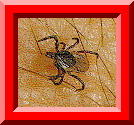 Tick (Ixodes ricinus).
Now to the more serious one.
This little animal of a millimeter size
can make your life miserable. If itself infected, it transmits
two rather nasty diseases, the meningoencephalitis and the Lyme boreliosis
(maybe none of them, maybe one, and maybe both). Only a certain fraction
of the ticks is infected by either borelia burgdorferi bacteria or the
encephalitis virus, but take no risks. It has not been fully explored
yet, but ticks seem to detect warmth of your body and are attracted
by it, but you can also pick one up at random, in the forest undergrowth,
or from a branch of a tree. The tick then finds a safe spot on your
body where it can easily escape undetected until it's too late,
typically on softer parts of skin like the back side of the knee joint,
under the armpit, between the toes, behind the ear, but expect even the
most obscure locations, including under your eyelid (although you should
notice this one), but rarely in the scalp. Even without knowing the
details of these two diseases (the symptoms of boreliosis very much
resemble those of syphillis and the disease is treated with antibiotics
if discovered at an early stage), take my word for it: do anything to
avoid these guys. Wear long sleeves and trousers even in high summer,
wear a cap or a hat, apply repellents, and make a thorough daily inspection
of your body. First of all: Don't panic!
1) Ticks don't really like altitudes of more than
1500 metres or so (but you have to get there somehow). 2) They don't
like winter and cold months. To move around and multiply, they also need
animals and foliage. 3) Even in lower altitudes and high summer,
they don't in general rain from the leaves (although I know of places where
they do). 4) Action: Remove the tick by a specially designed
pincette (drug store) or apply alcohol or anything similar to force
the tick come out of the skin. Pull it out very gently.
But don't drown the tick in it, otherwise you'll have to pull it out
by force, almost certainly causing the (possibly infected,
and barely visible) tick's head to stay in the skin, which is bad.
Disinfect the wound. Even an unifected tick's bite will leave you an
itching red spot for weeks. If you're uncertain, go see a doctor.
In Ljubljana, the Clinic for infectious diseases does the job properly.
Tick (Ixodes ricinus).
Now to the more serious one.
This little animal of a millimeter size
can make your life miserable. If itself infected, it transmits
two rather nasty diseases, the meningoencephalitis and the Lyme boreliosis
(maybe none of them, maybe one, and maybe both). Only a certain fraction
of the ticks is infected by either borelia burgdorferi bacteria or the
encephalitis virus, but take no risks. It has not been fully explored
yet, but ticks seem to detect warmth of your body and are attracted
by it, but you can also pick one up at random, in the forest undergrowth,
or from a branch of a tree. The tick then finds a safe spot on your
body where it can easily escape undetected until it's too late,
typically on softer parts of skin like the back side of the knee joint,
under the armpit, between the toes, behind the ear, but expect even the
most obscure locations, including under your eyelid (although you should
notice this one), but rarely in the scalp. Even without knowing the
details of these two diseases (the symptoms of boreliosis very much
resemble those of syphillis and the disease is treated with antibiotics
if discovered at an early stage), take my word for it: do anything to
avoid these guys. Wear long sleeves and trousers even in high summer,
wear a cap or a hat, apply repellents, and make a thorough daily inspection
of your body. First of all: Don't panic!
1) Ticks don't really like altitudes of more than
1500 metres or so (but you have to get there somehow). 2) They don't
like winter and cold months. To move around and multiply, they also need
animals and foliage. 3) Even in lower altitudes and high summer,
they don't in general rain from the leaves (although I know of places where
they do). 4) Action: Remove the tick by a specially designed
pincette (drug store) or apply alcohol or anything similar to force
the tick come out of the skin. Pull it out very gently.
But don't drown the tick in it, otherwise you'll have to pull it out
by force, almost certainly causing the (possibly infected,
and barely visible) tick's head to stay in the skin, which is bad.
Disinfect the wound. Even an unifected tick's bite will leave you an
itching red spot for weeks. If you're uncertain, go see a doctor.
In Ljubljana, the Clinic for infectious diseases does the job properly.
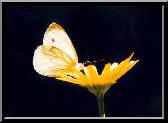 Butterfly 1.
The one thing I'm definitely not an expert on,
are butterflies,
so anyone that can give me a hint on their English names is welcome.
Under `Butterfly 1, 2, 3, 4' I merely collected four photos of
butterflies, taken in the valley of Knezca near Baska grapa,
at the southernmost outskirts of the Julian Alps. Unfortunately,
this valley, also known as the `butterfly valley' for its many species of
butterflies, is slowly but surely being ruined by small
hydro power plants.
Butterfly 1.
The one thing I'm definitely not an expert on,
are butterflies,
so anyone that can give me a hint on their English names is welcome.
Under `Butterfly 1, 2, 3, 4' I merely collected four photos of
butterflies, taken in the valley of Knezca near Baska grapa,
at the southernmost outskirts of the Julian Alps. Unfortunately,
this valley, also known as the `butterfly valley' for its many species of
butterflies, is slowly but surely being ruined by small
hydro power plants.
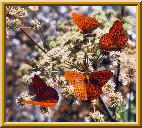 Butterfly 2.
See above.
Butterfly 2.
See above.
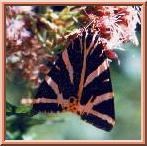 Butterfly 3.
See above.
Butterfly 3.
See above.
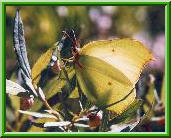 Butterfly 4.
See above.
Butterfly 4.
See above.
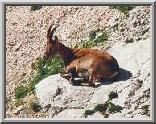 Ibex 1.
Ibex (Capra ibex; the capricorn) is a fine animal
with a dignified and proud stance. It can be up to 1.6m
long, 85cm high, and can weigh up to 100kg. Both male and female
carry large horns, and in a male ibex they can be as much as 100cm
long and can weigh 10 to 15kg. In the female, they are smaller
and resemble those of a goat. The hide is dense and thick and
its colour varies throughout the seasons of the year. In winter,
it is coarser, curly and dull, whereas it is shorter, softer,
much thinner, and more shiny in summer.
Ibex 1.
Ibex (Capra ibex; the capricorn) is a fine animal
with a dignified and proud stance. It can be up to 1.6m
long, 85cm high, and can weigh up to 100kg. Both male and female
carry large horns, and in a male ibex they can be as much as 100cm
long and can weigh 10 to 15kg. In the female, they are smaller
and resemble those of a goat. The hide is dense and thick and
its colour varies throughout the seasons of the year. In winter,
it is coarser, curly and dull, whereas it is shorter, softer,
much thinner, and more shiny in summer.
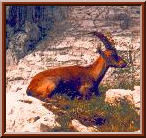 Ibex 2.
Already centuries ago, the capricorns became almost extinct.
If there weren't for a program of their protection in the 18th century,
they might be gone forever by now. One can read in old reports
and stories that the capricorns lived in the mountains of Switzerland,
and also throughout all Alpine territories in the prehistoric age.
In the times of the Roman Empire, they must have been very numerous,
since it was quite common to bring 100 to 200 capricorns to Rome
just for the sake of the people's entertainment. But already in the
15th century, they were starting to disappear from Switzerland,
and in the Glarus canton, the last capricorn was shot in 1550.
It still managed to survived in the Bergell and Engadin,
even more so after 1612 when the capricorn hunters wer punished
with a fine of 50 crowns and even a corporal punihsment 20 years later.
The last resort of the capricorns was, how prosaically,
the Gran Paradiso in Italy. They survived there when they were
already extinct throughout Germany, Austria, Switzerland,
and parts of Italy other than Gran Paradiso. It was from here
that they were reintroduced to the habitats they had before.
They were also brought to Slovenia, to Karavanke, by the baron Born
in 1897. Eight of his capricorns survived the second world war.
After the war, they were also introduced to other parts of our moutains.
The capricorns shown in these figures were all photographed on different
occasions on the plateau of Kriski podi above the Trenta and Vrata valleys.
In years when not decimated by psoriasis or other diseases,
the capricorns and the chamois are unforgettable companions on
your journeys, more or less to be found in quieter places on early
mornings.
Ibex 2.
Already centuries ago, the capricorns became almost extinct.
If there weren't for a program of their protection in the 18th century,
they might be gone forever by now. One can read in old reports
and stories that the capricorns lived in the mountains of Switzerland,
and also throughout all Alpine territories in the prehistoric age.
In the times of the Roman Empire, they must have been very numerous,
since it was quite common to bring 100 to 200 capricorns to Rome
just for the sake of the people's entertainment. But already in the
15th century, they were starting to disappear from Switzerland,
and in the Glarus canton, the last capricorn was shot in 1550.
It still managed to survived in the Bergell and Engadin,
even more so after 1612 when the capricorn hunters wer punished
with a fine of 50 crowns and even a corporal punihsment 20 years later.
The last resort of the capricorns was, how prosaically,
the Gran Paradiso in Italy. They survived there when they were
already extinct throughout Germany, Austria, Switzerland,
and parts of Italy other than Gran Paradiso. It was from here
that they were reintroduced to the habitats they had before.
They were also brought to Slovenia, to Karavanke, by the baron Born
in 1897. Eight of his capricorns survived the second world war.
After the war, they were also introduced to other parts of our moutains.
The capricorns shown in these figures were all photographed on different
occasions on the plateau of Kriski podi above the Trenta and Vrata valleys.
In years when not decimated by psoriasis or other diseases,
the capricorns and the chamois are unforgettable companions on
your journeys, more or less to be found in quieter places on early
mornings.
 Ibex 3-9.
The capricorns walk around in small herds. Opposite to the chamoises,
the capricorns graze also during the night. In summer, their
favourite place during the night is a forest, with an open end
at the top, not more than a few minutes' walk away. At sunrise,
they leave the forest and graze until they're full, and then they
sit down in a spot that seems appropriate and warm, sunny and
comfortable enough, facing east or south. They always use the
same tracks to move around, and they also prefer the same resting
spot, most commonly with a protective rock wall at the back
and with an good overview at the front.
Ibex 3-9.
The capricorns walk around in small herds. Opposite to the chamoises,
the capricorns graze also during the night. In summer, their
favourite place during the night is a forest, with an open end
at the top, not more than a few minutes' walk away. At sunrise,
they leave the forest and graze until they're full, and then they
sit down in a spot that seems appropriate and warm, sunny and
comfortable enough, facing east or south. They always use the
same tracks to move around, and they also prefer the same resting
spot, most commonly with a protective rock wall at the back
and with an good overview at the front.
The capricorns move with an unbelievable grace and make extremely secure steps. To jump around in an almost vertical rock face of a mountain, even the smallest indentations or bumps, barely visible to the human eye, are sufficient to them (Brehm, the author of the famous book on animals, also mentions an episode from a ZOO: a young capricorn jumped, with not much visible effort, to the top of a man's head, and stayed there). When a capricorn is frightened, it sneezes, when it's angry, it exhales rapidly through the nose. Only the youngsters utter voices similar to the `mbeee' of a sheep. They particularly like to fight, either in play or in a mating procedure, but the fights never end up with injuries. Capricorns avoid dangerous animals and are rather benign to those inferior to them. They don't like chamoises.
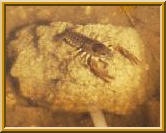 Crab.
This crab was photographed
in his brook on Bloska planota,
on a warm autumn day. The Bloska planota (a plateau, also known
as Bloke, named after its central village), is a relatively
peaceful part of Slovenia, peaceful enough to host brown bears.
Crab.
This crab was photographed
in his brook on Bloska planota,
on a warm autumn day. The Bloska planota (a plateau, also known
as Bloke, named after its central village), is a relatively
peaceful part of Slovenia, peaceful enough to host brown bears.
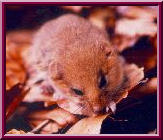 Forest mouse
(Apodemus sylvaticus).
This is one cool mouse. Even today, years after I took
this photo, I find it difficult to believe that it was ready to
pose for me at so many different angles. I can still remember that
it was a relatively cold autumn day when I visited Gamsov skret
in the Kamniske Alps with a friend, and this guy came up,
cheering us up immensely. This is one of my dearest photos
of all times.
Forest mouse
(Apodemus sylvaticus).
This is one cool mouse. Even today, years after I took
this photo, I find it difficult to believe that it was ready to
pose for me at so many different angles. I can still remember that
it was a relatively cold autumn day when I visited Gamsov skret
in the Kamniske Alps with a friend, and this guy came up,
cheering us up immensely. This is one of my dearest photos
of all times.
The forest mouse has most of the characteristics of an ordinary house mouse. It lives to up to 2000m high in forests, forest edges, gardens, and fields, and seeks for shelter in houses, barns and cellars during the winter. Outside, it eats fruits, all sorts of dried nuts, but also bugs, worms, and even smaller birds. It gathers food for the winter, but does not sleep it over; nevertheless it only uses the collected food supplies in times of bad weather or when in great need. The 4 to 8 youngsters are born two to three times a year and grow very slowly. Only after the first year of life, they get the wonderful, yellowish-red-brown hair.
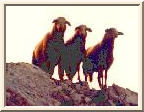 Sheep.
The same goes for these three sheep.
When we woke up in the small
bivouac Pod Skuto (in the Kamniske Alps) at about 2000 metres altitude,
we definitely weren't expecting three sheep to watch us incredulously
from a nearby rock as three graces. But this is what happened and
I took this funny photo.
Sheep.
The same goes for these three sheep.
When we woke up in the small
bivouac Pod Skuto (in the Kamniske Alps) at about 2000 metres altitude,
we definitely weren't expecting three sheep to watch us incredulously
from a nearby rock as three graces. But this is what happened and
I took this funny photo.